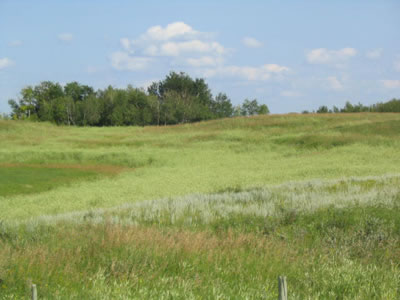
 |
|
Qu'Appelle Valley Geolog Stop 10 - Qu'Appelle Moraine
[ Previous Stop ] [ Next Stop ] This area is characterized by hummocky moraines and kettles. A moraine is an accumulation of glacial till left behind by melting glaciers. As glaciers moved across the prairies, they often collected soil, plants, and rocks and pushed these things along their paths. As the glaciers melted, this disorganized material, called till, was deposited along the terrain. Over time these deposits settled onto the earth and were covered by soil, becoming part of the terrain they were deposited on. These deposits were more elevated than the terrain, and as they were covered over they changed the landscape to look hummocky and uneven. Geologists call each of these deposits a moraine. Kettles, on the other hand, were formed by ice-blocks left behind by glaciers during their advance. Over time these ice-blocks were covered with soil and till, but did not melt. Rather, they stayed underground and land formed around them. However, as the ice age ended and the temperature of the area rose, the ice-blocks began to melt. As the ice-blocks melted, the soil above them collapsed, making depressions called kettles. Over time these depressions became filled with water and pond-deposit, making kettle-ponds. Kettle-ponds appear marshy and have many marsh-like characteristics. In fact, much of the vegetation found in these kettles is the similar to those found in marshes. Fauna that love marshes, such as ducks and insects, will come here to breed as they would in a marsh. Kettles found on farmland also serve another purpose as they help to provide water for cattle and irrigate crops.
What is interesting to note is the kettle-pond featured at Stop 10 of the original Geolog Tour no longer exists. The outline of the pond is still visible, but the water has evaporated. Grass and other vegetation has filled in the depression - more evidence of how quickly the landscape changes over time.

Plant species found at stop 10:
|
Page last updated on
2004-10-08 |